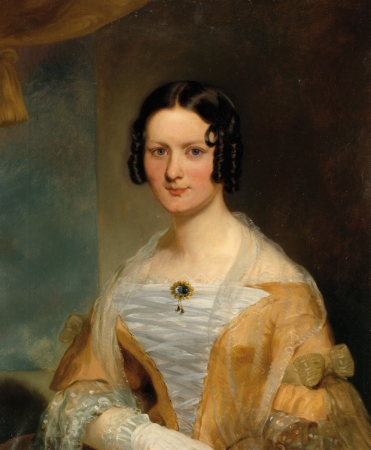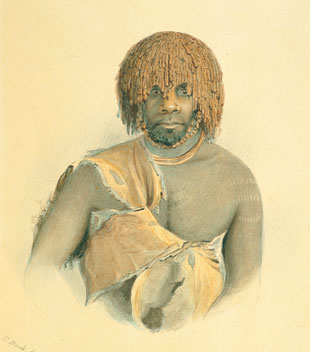The final solution down under in Tasmania…
…Macquarie House bustled with activity. Colonel George Arthur, the governor, himself assumed command of the operation and planned the cordon- “the Black Line”- on the most orthodox military principles. He had fought in the Napoleonic Wars and put down a slave revolt in Honduras. Upstairs, he and his staff officers spread their maps and plotted their dispositions. Downstairs there came and went, saluting and swishing their capes and rattling their swords, the officers of the three regular regiments committed to the operation and an enthusiastic gallimaufry of volunteers who swarmed about the house in a state of belligerent anticipation.

—‘An artist of considerable ability, and very respectably connected in the colony’, Henry Mundy (c. 1798–1848) flourished in Van Diemen’s Land during the late 1830s before his success as a portrait painter withered in the economic woes of the succeeding decade. The final years of his life, according to acquaintances, were marked by alcoholism and ‘irregular habits’ as well as the ‘occasional state of temporary insanity’ that was declared to have ‘urged him to the commission of the awful deed’ of suicide in March 1848. Mundy had checked into the Ship Hotel on Collins Street and retired to his room after a couple of ales and a cigar. He died soon after being found ‘insensible’ on his bed the following morning with an almost-empty laudanum bottle on the table beside him and in his pocket a letter demanding payment of a debt….Read More:http://www.portrait.gov.au/magazine/article.php?articleID=67
Arthur timed the campaign for the weeks before the harvest, calling upon every farm to send an able-bodied volunteer, and he conscripted ticket-of-leave men, cautiously commissioning police magistrates to be their officers in the field. In all, some 2,500 men were engaged. In case the settlers took the operation too lightly- some of them were, after all, accustomed to chase aborigines in innocent blood-sport- the government publicly warned the participants that it “was not a matter of amusement or recreation, but a cause of the most important and serious kind, in which the lives and property of the whole community are more or less at stake.”
Martial law was proclaimed against the native population, except for those who “there may be reason to suppose are pacifically inclined,” and Arthur himself, ordering his charger saddled and kissing a soldiery farewell to his pregnant wife, rode away from Macquarie House to lead his troops into action.

—Dowling’s re-presentations of Bock’s images found their way to the Ethnological Society of Britain and the Royal Academy where they fed the interest in anthropology and primitive societies. Although these paintings were created in London, using sketches from Bock’s originals and they eventually found their way back to Australia as part of the swirl of cultural artefacts throughout the Empire.—click image for source…
It was perhaps the most farcical campaign in the history of British imperial arms. The plan called for a steady advance on a front that would begin by being a 120 miles long, but would narrow in the course of the march until its two flanks, swinging in an arc around the island, were united like a noose in the peninsula….( to be continued)…
ADDENDUM:
(see link at end)…In reality, the black line was a complete failure and it did not result in the “systematic annihilation” of Aborigines, as Isaacs declared. Despite the cost, the time, and the manpower invested in it, the line only netted one man and one boy. In that regard, it was a bit like America spending billions of dollars on the invasion of Afghanistan, yet failing to eliminate Al Qaeda or catch Osama Bin Laden. In the context of war propaganda, America’s failure was demoralising for themselves, but inspiring for their enemies. Likewise, the ability of the two tribes to outwit their adversary was potentially far more inspiring history than that of a weak race passively going into oblivion. The fact that Isaacs choose to portray Aborigines as victims of the black line instead of victors over it, revealed a great deal about her ideology and moral character. Perhaps it also indicated her desire to tell a story in an emotional way for racist or commercial reasons, instead of an honest way for educational reasons.
In addition to omitting the fact that the line failed, the historians have omitted the true purpose. It was not designed to exterminate Aborigines, rather, it was designed to relocate two of the nine tribes on the island to uninhabited country from where they would no longer be in conflict with the whites, or be “corrupted” by whites. According to Governor Arthur (the man who devised the line), if Aborigines were not relocated, they would become extinct. In his own words:
“It was evident that nothing but capturing and forcibly detaining these unfortunate savages … could now arrest a long term of rapine and bloodshed, already commenced, a great declin
the prosperity of the colony, and the extirpation of the Aboriginal race itself.”Because it was a policy of relocation, rather than eradication, it had more in common with the partition of Palestine that led to the creation of Israel than it did with the Nazis’ final solution for the Jews. Maybe the people in the UN who divided Palestine were selfish and facilitated the cultural loss of the Palestinians by depriving them of access to sacred sights, but that didn’t change the fact that they believed they were doing the right thing. Read More:http://www.convictcreations.com/history/aborigines.html





 COMMENTS
COMMENTS